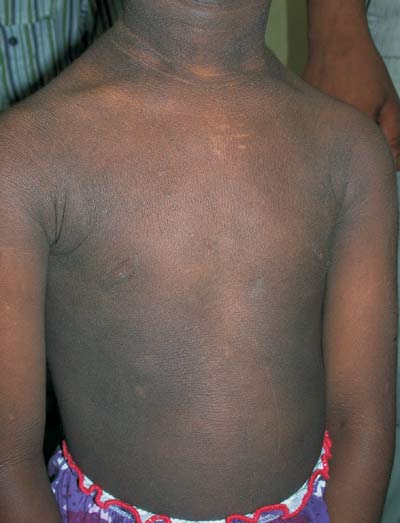A 4-year-old girl, born of a non-consanguineous marriage
with normal growth and developmental milestones, presented
with asymptomatic generalized hyperpigmentation. It started
spontaneously at the age of 2 years, around the neck and
axilla, and spread insidiously to involve the other parts of
body. The skin gradually became thickened and rugose. There
was no history of drug intake, polyuria, polydypsia, loss of
appetite, excess weight gain or loss. Cutaneous examination
revealed generalized hyperpigmentation with thickening of
skin, which was accentuated in the back and sides of the
neck, axillae, groins, dorsal hands and flexural areas of
knees and elbows. The characteristic velvety plaque with
corrugated surface could be appreciated in the flexures (Fig.1).
Mucous membranes, palms, soles, hair, and nails were
unremarkable. Routine investigations, thyroid profile,
insulin level, lipid profile, complete liver and renal
function tests, and oral glucose tolerance test were within
normal limits. Histopathological examination revealed marked
hyperkeratosis, acanthosis and papillomatosis and was
consistent with diagnosis of acanthosis nigricans.
Epidermolytic hyperkeratosis was excluded on the basis of
absence of bullous lesions and histopathological findings.
Absence of mucosal and systemic involvement, and velvety
texture of lesions in our patient were against the diagnoses
of hemochromatosis and Addison’s disease.
 |
|
Fig.1 Generalized
hyperpigmentation associated with velvety skin
thickening with corrugated surface.
|
Generalized acanthosis nigricans, as seen
here is rare and is most commonly seen in adults with an
underlying malignancy. Age of onset more than 40 years,
symptomatic (generalized pruritus), rapid progression and
involvement of atypical sites such as mucosa (tongue and
lips), Palm ("Tripe palm") and soles are clinical indicators
of underlying malignancy. These findings were absent in our
patient. The treatment is directed towards treating the
underlying cause that includes, either weight reduction,
discontinuation of offending drugs, correction of
endocrinological abnormality or underlying malignancy.
Emollients, keratolytics (topical retinoids, salicylic acid,
lactic acid, urea), calcipotriol, systemic retinoids, CO2
laser ablation, and long-pulsed alexandrite laser may
improve appearance.

